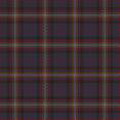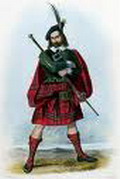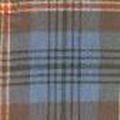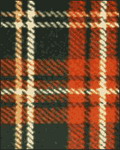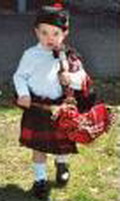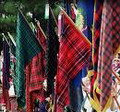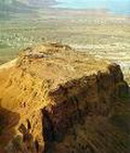|
Tartan in Ancient Britain and in Masada of Judah The Tartan Coat of Many Colors and Joseph This is Page 5 Continued from Page 4 |
7.Masada and Tartan Garments from Ancient Britain Contents:1. Truth or Hoax? 2. Masada. Extracts from Wikipedia 3. The Significance of Masada in Present-Day Israel. President Bush in the Knesset 4. Yair Davidiy as a Soldier at Masada 5. Tartan from Britain at Masada 6. Brit-Am, The Ten Tribes Movement, and Tartan at Masada. 7. Conclusion
1. Truth or Hoax? Did the Ancient Britons in Roman times wear tartan cloaks? They may have done. Reports indicate that such designs were also known amongst the Gauls in present-day France. A fragment of woolen cloth bearing a tartan design near the Antonine wall (that protected Roman Britain from the Picts) has been found from Falkirk in Scotland. It is estimated to dated from the 200s CE. A British newspaper report ("The Independent" 31.1.95) claimed that woollen tartan garments imported from Britain were worn by the Jewish defenders of Masada in 66 CE in their revolt against Rome. Who knows if they did not actually belong to volunteers from Scotland who came to help the Jews in their War of Independence? Alternatively the report may have been a hoax or a mistake? Things like this happen. Anyway the information so far has not been confirmed. It is too good not to mention but not credible enough to rely on without further evidence. 2. Masada. Extracts from Wikipedia http://en.wikipedia.org/wiki/Masada Masada (Hebrew , pronounced Metzada, from , metzuda, "fortress") is the name for a site of ancient palaces and fortifications in the South District of Israel on top of an isolated rock plateau, or large mesa, on the eastern edge of the Judean Desert overlooking the Dead Sea. After the First Jewish-Roman War a siege of the fortress by troops of the Roman Empire led to the mass suicide of the Sicarii rebels, who preferred death to surrender. The cliffs on the east edge of Masada are about 1,300 feet (400 m) high and the cliffs on the west are about 300 feet (90 m) high; the natural approaches to the cliff top are very difficult. The top of the plateau is flat and rhomboid-shaped, about 1,800 feet (550 m) by 900 feet (275 m). There was a casemate wall around the top of the plateau totaling 4,300 feet (1.3 km) long and 12 feet (3.7 m) thick, with many towers, and the fortress included storehouses, barracks, an armory, the palace, and cisterns that were refilled by rainwater. Three narrow, winding paths led from below up to fortified gates. According to Josephus, a first-century Jewish Roman historian, Herod the Great fortified Masada between 37 and 31 BCE as a refuge for himself in the event of a revolt. In 66 CE, at the beginning of the First Jewish-Roman War against the Roman Empire, a group of Jewish extremists called the Sicarii overcame the Roman garrison of Masada. After the destruction of the Temple, the Jewish rebels and their families fled Jerusalem and settled on the mountain top, using it as a base for raiding Roman settlements.[1] The Sicarii on Masada were commanded by Elazar ben Ya'ir .... Archaeology indicates that they modified some of the structures they found there; this includes a building which was modified to function as a synagogue ...Remains of two mikvahs were found elsewhere on Masada. In 72, the Roman governor of Iudaea Lucius Flavius Silva marched against Masada with the Roman legion X Fretensis and laid siege to the fortress. After failed attempts to breach the wall, they built a circumvallation wall and then a rampart against the western face of the plateau, using thousands of tons of stones and beaten earth. When they entered the fortress...the Romans discovered that its 960 inhabitants had set all the buildings but the food storerooms ablaze and committed mass suicide rather than face certain capture, defeat, slavery or execution by their enemies. The site of Masada was identified in 1842 and extensively excavated between 1963 and 1965 by an expedition led by Israeli archeologist Yigael Yadin. While a hike up the Snake Path on the eastern side of the mountain (access via the Dead Sea Highway) is considered part of the "Masada experience," a cable car operates at the site for those who wish to avoid the physical exertion. The Chief of Staff of the Israel Defence Forces (IDF), Moshe Dayan, initiated the practice of holding the swearing-in ceremony of soldiers who have completed their Tironut (IDF basic training) on top of Masada. The ceremony ends with the declaration: "Masada shall not fall again." The soldiers climb the Snake Path at night and are sworn in with torches lighting the background.[6] This is a reference to the Jewish revolt in 70 AD, where 900 Jewish fighters committed suicide, leading to the fall of the fort to the Romans. A 2,000-year-old seed discovered during archaeological excavations in the early 1960s has been successfully germinated to become a date plant, the oldest known such germination.[8] 3. The Significance of Masada in Present-Day Israel. President Bush in the Knesset At the top of Masada you can see where archaeologists have revealed the ancient fortifications, apartments, and ritual purification baths (mikvaot) that once existed in the fortress. The Fortress was well nigh impregnable and it took the Romans a long time and a lot of effort before they were able to capture it. The surviving Jewish defenders of Masada committed suicide rather than surrender to the Romans. One of the most famous slogans of the present State of Israel says: "Shenit Matsada lo tipol" i.e. Masada will not fall again! The importance of Masada and what it stands for was referred to by President Bush in his speech to the Knesset Jerusalem News-769 http://britam.org/jerusalem/jerusalem769.html#Bush #7. Bush to Knesset: U.S. stands with Israel, Masada will not fall again http://www.haaretz.com/hasen/spages/983716.html Jerusalem News-770 # 2. Speech of President Bush to the Knesset http://britam.org/jerusalem/jerusalem770.html#Speech President Bush said: ## I have been fortunate to see the character of Israel up close. I have touched the Western Wall, seen the sun reflected in the Sea of Galilee, I have prayed at Yad Vashem. And earlier today, I visited Masada, an inspiring monument to courage and sacrifice. At this historic site, Israeli soldiers swear an oath: "Masada shall never fall again." Citizens of Israel: Masada shall never fall again, and America will be at your side.## 4. Yair Davidiy as a Soldier at Masada The Destiny of Joseph http://britam.org/tape4.html Extract: # I, myself, Yair Davidiy, once served in the Israeli Army in the Armored Corps. I was eventually to become a member of a unit of Infantry Soldiers attached to the Armored Corps. We traveled around in Armored Personnel Carriers. Our job, in principle, was to work together with the tanks and to do things that the tanks could not do such as attack enemy Infantry holed up inside caves who were threatening the position of the tanks, and similar tasks. Both the soldiers who drove the tanks and the Infantry soldiers, such as myself, who were to assist them and traveled besides them in Armored Personnel Carriers did the same basic training at first. We were all part of the Armored Corps in the Israeli Army. At the completion of our basic training in the Armored Corps we had a ceremony. We all traveled to the Judaean Desert at nighttime. We walked up the very steep slope of the fortress of Masada by torchlight and at the top we had a Ceremony of Acceptance into the Armor Corps. We had an Induction. Every soldier had his name called out and then he ran forward where he was congratulated and he was presented with a copy of the Hebrew Bible and he was given his rifle. It was all quite impressive. [Recent reports indicate that the IDF is not at ease with the suicidal attitude identified with Masada and now prefers that swearing-in ceremonies take place by the Western Wall in Jerusalem.] 5. Tartan from Britain at
Masada ("The Independent" 31.1.95
article by David Keys, Archaeology Correspondent, commenting on an exhibition
held at the British Museum of textiles found at
Masada;
Information obtained from Dr. Clifford Smyth of Belfast, U.K.). |




|
